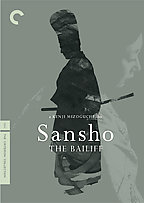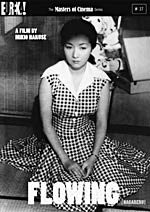 Another very intense Japanese movie this time by Kenji Mizoguchi. This black and white 1954 masterpiece is the most touching epic folk tale that I have ever seen, but I know that is Mizoguchi master storyteller and filmmaker abilities that make this film outstanding with astonishing images of visual beauty that never deadens the power of this human drama and Mizoguchi’s sense of outrage against oppression.
Another very intense Japanese movie this time by Kenji Mizoguchi. This black and white 1954 masterpiece is the most touching epic folk tale that I have ever seen, but I know that is Mizoguchi master storyteller and filmmaker abilities that make this film outstanding with astonishing images of visual beauty that never deadens the power of this human drama and Mizoguchi’s sense of outrage against oppression.
I’m including some words from a 2002 article that will help me to give an idea of what an incredible movie I just have seen.
Sanshô Dayû, in any case, transcends all reservations. It is the triumphant summation of Mizoguchi's style and themes, as well as the most compassionate response imaginable to those atrocities which had been committed in then very recent years, in Japan and all over the world. It is the most humanist of films, but it asserts that humanism is powerless without politics, just as politics is purposeless without humanism. The last sequence is the most perfect ending in cinema, so broad in implication, so exquisite in form. The reunion of mother and son – the revelation of human love – is at once the most important thing in the world, and an event insignificant against the panorama of human suffering. The double perspective – never to see things in isolation, always in context – is assured by Mizoguchi's style, and defines his art. Sanshô Dayû is, in Gilbert Adair's words, “one of those films for whose sake the cinema exists” If any art has justified this medium, so often crude, thoughtless and mundane, it is the art of Kenji Mizoguchi.
Truth is that I’m exhausted. This film gave so many intense emotions and couldn’t help but think that it has so many parallelism to today, as what it was said in the article, “humanism is powerless without politics, just as politics is purposeless without humanism”, very wise words and powerful insight about the world’s past, the world’s present and the world’s future.
The film is incredibly sad but I am not one little bit sorry for seeing this high quality drama that since the beginning will take you into a voyage of seeing what’s happening, imagining what comes next, wanting to stop what you’re seeing in the screen, feel relief, feel angst, feel devastated, the end.
My true feeling right now is that I’m glad that I was able to see this film before dying and I know I will revisit this film once and hopefully many more times in the future. Yes, probably is the best movie I have ever seen, the one with the most higher production values, the most complete, and the most perfect. This is perfect symbiosis of substance and style.
I’m still full of emotions, but let me tell you about the story that is based on a tale by Ogai Mori with screenplay by Fuji Yahiro Yishikata Yoda. It starts by telling you that “the origin of this legend of Sanshô Dayû goes back to medieval times when Japan had not yet emerged from the Dark Ages and mankind had yet to awaken as human beings. It has been retold by the people for centuries and it’s treasured today as one of the epic folk tales of our history”. Basically is about a kind governor that looses power for being so kind; his wife, son and daughter that have to go to live with the wife's brother and when the kids are older decide to reunite with the former governor who is in exile. From there on a series of misfortunes happens to the wife Tamaki, the son Zushio and the daughter Anju.
The mother is played by Kinuyo Tanaka that is another of the female Mizoguchi icons and she was also in Flowing and The Life of Oharu. The film won the Silver Lion in the 1954 Venice Film Festival.
Last, I read a review from a critic that said that this film is “Serious as a heart attack and so emotionally wrenching that it's almost difficult to watch” and believe me is totally true.
This is the ONE movie you have to see at least once in your lifetime.
 Today, August 7, 2017 organizers announce three (3) more films in the selection, one is out of competition, another is a special screening and the last one is a documentary in Venezia Classici section.
Today, August 7, 2017 organizers announce three (3) more films in the selection, one is out of competition, another is a special screening and the last one is a documentary in Venezia Classici section.




















No comments yet